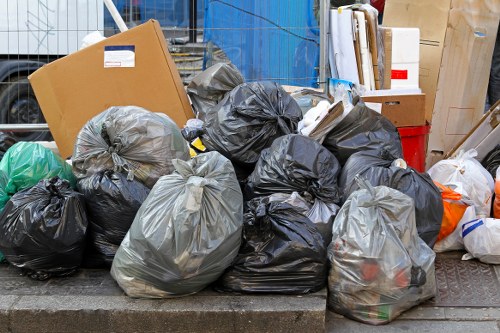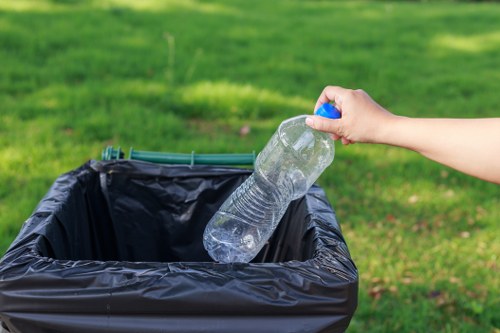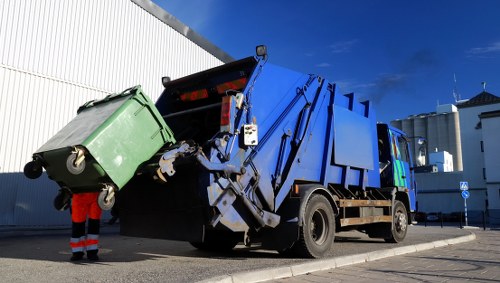Efficient Construction Waste Clearance in Thamesmead
Introduction to Construction Waste Clearance

Construction sites generate a significant amount of waste, which can pose environmental and safety hazards if not managed properly. Effective construction waste clearance in Thamesmead is essential for maintaining a clean and safe work environment.
Thamesmead, a vibrant area in London, has seen substantial development in recent years, leading to increased construction activities. With this growth comes the responsibility to handle construction debris responsibly.
Proper waste clearance not only ensures compliance with local regulations but also contributes to sustainability by promoting recycling and reducing landfill usage.
Types of Construction Waste

Construction waste encompasses a variety of materials, each requiring specific handling and disposal methods. Understanding the different types is crucial for effective clearance.
Common types of construction waste include:
- Concrete and masonry
- Wood and timber
- Metal scraps
- Plastics and packaging
- Insulation materials
Each material has its own recycling potential, and proper segregation can significantly reduce the environmental impact.
Regulations Governing Waste Clearance

In Thamesmead, as with the rest of London, construction waste clearance is governed by strict regulations to ensure environmental protection and public safety.
Key regulations include:
- Waste Management Licensing
- Health and Safety Standards
- Environmental Protection Act Compliance
- Landfill Directives
Adhering to these regulations is not only a legal requirement but also a commitment to sustainable construction practices.
Benefits of Professional Waste Clearance Services

Hiring professional construction waste clearance services in Thamesmead offers numerous advantages over DIY waste management.
Benefits include:
- Expertise in waste segregation and recycling
- Compliance with local laws and regulations
- Efficient removal and disposal, saving time and labor
- Reduced risk of site accidents related to waste accumulation
Professional services ensure that waste is handled responsibly, minimizing environmental impact.
Steps Involved in Waste Clearance

The process of construction waste clearance involves several key steps to ensure efficient and compliant removal of debris.
Here’s an overview of the typical process:
- Site Assessment: Evaluating the types and quantities of waste present.
- Planning: Developing a clearance plan tailored to the project’s needs.
- Segregation: Sorting waste into recyclable and non-recyclable categories.
- Removal: Safely transporting waste to designated disposal or recycling facilities.
- Final Cleanup: Ensuring the site is free from debris and ready for the next phase of construction.
Following these steps ensures a systematic and effective waste clearance operation.
Recycling and Sustainability
The Importance of Recycling Construction Waste
Recycling construction waste plays a vital role in promoting sustainability within the industry. By diverting materials from landfills, we conserve resources and reduce environmental impact.
Recyclable Materials
- Metals: Steel, aluminum
- Wood: Plywood, timber
- Concrete and bricks
- Glass and plastics
Implementing Sustainable Practices
Adopting sustainable waste clearance practices includes:
- Maximizing recycling rates
- Using eco-friendly disposal methods
- Promoting the use of recycled materials in new constructions
Choosing the Right Waste Clearance Service
Selecting a reliable construction waste clearance service in Thamesmead is crucial for the success of your project. Consider the following factors when making your choice:
- Experience and reputation in the industry
- Range of services offered
- Compliance with local regulations
- Pricing and value for money
- Customer reviews and testimonials
Ensuring these factors align with your project’s needs will lead to a smoother waste management process.
Cost Factors in Waste Clearance
The cost of construction waste clearance in Thamesmead can vary based on several factors. Understanding these can help you budget effectively.
Key cost factors include:
- Volume and weight of waste
- Type of materials being disposed of
- Accessibility of the site
- Distance to disposal facilities
- Additional services required, such as recycling or hazardous waste handling
Discussing these factors with your service provider can provide a clear estimate tailored to your project.
Environmental Impact of Waste Clearance
Reducing Carbon Footprint
Effective waste clearance contributes to lowering the carbon footprint of construction projects by minimizing unnecessary waste and promoting recycling.
Energy Conservation
Recycling materials often consumes less energy compared to producing new materials, leading to significant energy savings.
Preserving Natural Resources
By reusing and recycling construction materials, we conserve natural resources, ensuring they remain available for future generations.
Innovative Waste Clearance Technologies
Advancements in technology have revolutionized construction waste clearance, making it more efficient and environmentally friendly.
Innovative technologies include:
- Automated sorting systems
- Advanced recycling machinery
- Real-time waste tracking software
- Eco-friendly disposal methods
These technologies enhance the effectiveness of waste management practices, ensuring a higher degree of sustainability.
Case Studies: Success Stories in Thamesmead
Examining successful construction waste clearance projects in Thamesmead provides valuable insights into best practices and effective strategies.
Notable case studies:
- Residential development with 90% waste recycling rate
- Commercial building project achieving zero landfill waste
- Infrastructure project utilizing innovative waste tracking systems
These examples demonstrate the feasibility and benefits of prioritizing waste clearance in construction projects.
Future Trends in Waste Clearance
The field of construction waste clearance is continually evolving, with emerging trends shaping the future of waste management.
Future trends include:
- Increased use of AI and machine learning for waste sorting
- Growth in circular economy practices
- Enhanced focus on biodegradable and sustainable materials
- More stringent regulatory standards
Staying informed about these trends allows businesses to adapt and implement cutting-edge waste clearance solutions.
Conclusion
Effective construction waste clearance in Thamesmead is pivotal for sustainable development and environmental protection. By understanding the types of waste, adhering to regulations, and utilizing professional services, construction projects can minimize their ecological footprint.
Embracing recycling and innovative technologies further enhances the efficiency and sustainability of waste management practices.
Contact us today to ensure your construction waste clearance needs are met with expertise and dedication.
Get Started with Your Waste Clearance
Ready to streamline your construction project’s waste management? Partner with the leading waste clearance experts in Thamesmead to achieve a cleaner, greener construction site.
Our team is equipped to handle all aspects of waste clearance, ensuring compliance and promoting sustainability.
Book your service now and take the first step towards responsible construction practices.